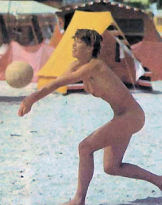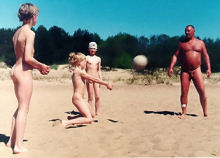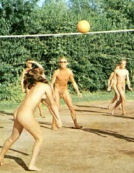 Support the web site, shop at our store!
Support the web site, shop at our store!
Sponsors
About Lake Como Bare Oaks White Tail White ThornHow To Help

Passing: The Basics
The most important part of the game and the most difficult part of the game. Almost all clinics and warm-ups begin with passing. Most of the time spent on drills in the clinics is spent on passing. Yet, its' still something few of us can do well.
There are many things that must be done to pass the ball correctly. The ball must hit the platform formed between your wrist and elbow (NOT YOUR HANDS!). Your elbows must be locked. Your knees need to be bent, almost as if you are sitting on a stool. You should be facing your target. There should be very little arm swing at the moment of contact. The hands should be together in a relaxed form.
All this and more, NEEDS to be done just to pass the ball well. To become a good passer, one has to do three more things:
- Be setup before the ball comes over the net. The good passers do this the best. Before the ball crosses to the net, their arms are extended and have formed a platform. This is the easiest of the three to do.
- Position yourself so that at the moment of contact with the ball, your hands are directly in front of your belly button. Not an easy thing to do but not impossible either.
- Follow the ball, with your eyes, all the way to the moment of contact. See the ball hit your arms.
Let me briefly discuss number two above. Have you ever been to a high school game and heard the coach yell at the players "MOVE YOUR FEET"? Give this a try. Set up in the passing position. Now move your platform six inches to the right. Your hands are no longer in front of your belly button. OK, now leave your hands right where they are. Leaving your hands right where they are, move your right foot one foot to the right. Now look at your hands. They are in front of your belly button. When you line up with the ball, you MUST move your feet and not your hands.
The above three components require concentration. You must know what you are going to do before you do it. The difference between an average passer and a good passer is the good passer knows what they are going to do before the ball crosses the net.
Passing: Refinement
Ok, I'm a novice player, I read and tried the information above on passing and did everything you said. It didn't work!

First let me begin with an exercise I do at the first practice of each season. I have all the players serve the ball with their left hand. I then explain we could work on this all season and at best, only get half our serves in by the end of the season. When you try something new it almost never works the first time.
Is the ball hitting your forearms or your hands? Are you in front of the ball? Did you swing? I find these are the three most difficult things for beginning passers. Your arms need to form a platform between your wrist and elbow and the ball must make contact on this platform. If the ball is hitting your hands you will never be able to pass. You must be in front of the ball. When the ball is served, you are a long way from the server. You should have plenty of time to get in front of the ball. Finally and most importantly, which direction and by how much did your platform move when the ball made contact. At most you are only ten feet from the setter. The ball does not need to travel far after you pass it. If your arms move as much as a quarter of an inch toward the net, the ball will go over the net. Try not swinging your arms at all. After you get in front of the ball just be a wall (walls don't move). Just let the ball hit your arms and see how far the ball goes. It has been my experience that beginning players get excited and over swing their arms when passing. Some beginners even jump when they are passing. The more relaxed one is the better one will pass.
I always tell players not to interlock their fingers when they are passing. Most passers rest one hand inside the other. I have noticed that the better passers just hold their hands side by side. Once I had a novice player tell me he interlocked his fingers so his hands would not come apart. For first year players this made sense. When just beginning, a number of players will just slap the ball up with the palms of their hands. This being a 'lift', play stops immediately. By locking ones fingers together, one cannot lift the ball. If this helps you get out of the habit of lifting, great. However, once you break the lifting habit, stop interlocking your fingers.
The first section mentioned a good passer needs to be setup
before the ball arrives (have your platform formed and be waiting for the ball),
 be in front of the ball and watch the ball all the way into your arms. I notice
a number of players getting set up before they get in front of the ball (like the photo
next to this paragraph). They
then move with their arms in an awkward position This may be my fault because
of the order I listed the above requirements. As you are moving to get in front
of the ball, have your hands in front of you with your elbows bent, as if you
were carrying a lunch tray. When you get in front of the ball, lock your elbows
and form your platform. Remember, nothing mentioned above will work if your
elbows are BENT! Your elbows must be locked.
be in front of the ball and watch the ball all the way into your arms. I notice
a number of players getting set up before they get in front of the ball (like the photo
next to this paragraph). They
then move with their arms in an awkward position This may be my fault because
of the order I listed the above requirements. As you are moving to get in front
of the ball, have your hands in front of you with your elbows bent, as if you
were carrying a lunch tray. When you get in front of the ball, lock your elbows
and form your platform. Remember, nothing mentioned above will work if your
elbows are BENT! Your elbows must be locked.
Finally a great little drill you can do indoors by your self all winter to develop and improve your passing skills. In your basement, place a chair about three feet from a brick wall. Sit on the edge of the chair with your knees wide apart and pass the ball into the wall. Pass the ball so that it comes right back to you and pass it again and again. If you get tired of passing, you can practice your setting the same way. When I practice my setting I like to sit on the floor not a chair.
